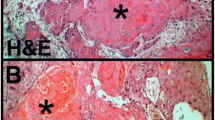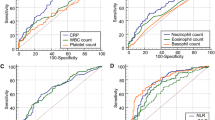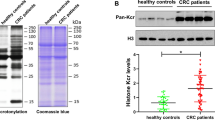Abstract
Introduction
The potential use of determination of biomarkers in blood for the monitoring of surgical removal of oral squamous cell carcinomas (OSCC) was evaluated using the epitope detection in monocytes (EDIM) technology.
Materials and methods
In tumor specimen, elevated Apo10 and transketolase-like 1 (TKTL1) expression was analyzed by immunohistochemistry. Apo10 and TKTL1 biomarkers have been used prospectively for EDIM blood test in patients with primary and/or recurrent OSCC (n = 92) before surgery and after curative tumor resection (n = 45).
Results
There were highly significant (p < 0.0001) correlations found between EDIM blood scores and the tissue expression of both biomarkers measured by immunohistochemistry (Apo10: n = 89/92, 97 %; TKTL1: n = 90/92, 98 %). EDIMApo10 and EDIM-TKTL1 scores were positive in 92 % (EDIM-Apo10: n = 85/92) and 93 % (EDIM-TKTL1: n = 86/92), respectively, in patients with OSCC before surgery. The combined score EDIM-Apo10/EDIM-TKTL1 increased significantly the detection rate of tumors to 97 % (n = 89/92). After surgery, the EDIM-TKTL1 and EDIMApo10 scores significantly decreased in 75.6 and 86.7 % of the patients (p < 0.0001), respectively, in the aftercare.
Conclusions
The correlation of TKTL1 and Apo10 immunohistochemistry with the blood test results indicates that the EDIM blood test could serve as a non-invasive diagnostic tool (liquid biopsy) to assess surgical removal of OSCC by determination of two biomarkers.
Clinical relevance
This is the first study that has been demonstrated a reliable and successful monitoring of OSCC cancer patients by a blood test. The specific and significant decrease of EDIM-TKTL1 and EDIM-Apo10 scores after surgery could serve as a new tool for monitoring surgical removal of OSCC.




Similar content being viewed by others
References
da Silva SD, Ferlito A, Takes RP, Brakenhoff RH, Valentin MD, Woolgar JA, Bradford CR, Rodrigo JP, Rinaldo A, Hier MP, Kowalski LP (2011) Advances and applications of oral cancer basic research. Oral Oncol 47(9):783–791. doi:10.1016/j.oraloncology.2011.07.004
Kowalski LP, Sanabria A (2007) Elective neck dissection in oral carcinoma: a critical review of the evidence. Acta Otorhinolaryngol Ital 27(3):113–117
Rethman MP, Carpenter W, Cohen EE, Epstein J, Evans CA, Flaitz CM, Graham FJ, Hujoel PP, Kalmar JR, Koch WM, Lambert PM, Lingen MW, Oettmeier Jr BW, Patton LL, Perkins D, Reid BC, Sciubba JJ, Tomar SL, Wyatt Jr AD, Aravamudhan K, Frantsve-Hawley J, Cleveland JL, Meyer DM, American Dental Association Council on Scientific Affairs Expert Panel on Screening for Oral Souamous Cell C (2012) Evidence-based clinical recommendations regarding screening for oral squamous cell carcinomas. Tex Dent J 129(5):491–507
Sawant SS, Zingde SM, Vaidya MM (2008) Cytokeratin fragments in the serum: their utility for the management of oral cancer. Oral Oncol 44(8):722–732. doi:10.1016/j.oraloncology.2007.10.008
Grimm M, Schmitt S, Teriete P, Biegner T, Stenzl A, Hennenlotter J, Muhs HJ, Munz A, Nadtotschi T, Konig K, Sanger J, Feyen O, Hofmann H, Reinert S, Coy JF (2013) A biomarker based detection and characterization of carcinomas exploiting two fundamental biophysical mechanisms in mammalian cells. BMC Cancer 13(1):569. doi:10.1186/1471-2407-13-569
Soland TM, Brusevold IJ (2013) Prognostic molecular markers in cancer—quo vadis? Histopathology 63(3):297–308. doi:10.1111/his.12184
Cheng SJ, Lee JJ, Cheng SL, Chen HM, Chang HH, Wang YP, Kok SH, Kuo MY, Chiang CP (2012) Increased serum placenta growth factor level is significantly associated with progression, recurrence and poor prognosis of oral squamous cell carcinoma. Oral Oncol 48(5):424–428. doi:10.1016/j.oraloncology.2011.12.007
Moergel M, Kammerer PW, Schnurr K, Klein MO, Al-Nawas B (2012) Spin electron paramagnetic resonance of albumin for diagnosis of oral squamous cell carcinoma (OSCC). Clin Oral Investig 16(6):1529–1533. doi:10.1007/s00784-011-0655-3
Shukla D, Kale AD, Hallikerimath S, Yerramalla V, Subbiah V (2013) Can quantifying free-circulating DNA be a diagnostic and prognostic marker in oral epithelial dysplasia and oral squamous cell carcinoma? J Oral Maxillofac Surg Off J Am Assoc Oral Maxillofac Surg 71(2):414–418. doi:10.1016/j.joms.2012.04.039
Jou YJ, Lin CD, Lai CH, Tang CH, Huang SH, Tsai MH, Chen SY, Kao JY, Lin CW (2011) Salivary zinc finger protein 510 peptide as a novel biomarker for detection of oral squamous cell carcinoma in early stages. Clin Chim Acta Int J Clin Chem 412(15-16):1357–1365. doi:10.1016/j.cca.2011.04.004
St John MA, Li Y, Zhou X, Denny P, Ho CM, Montemagno C, Shi W, Qi F, Wu B, Sinha U, Jordan R, Wolinsky L, Park NH, Liu H, Abemayor E, Wong DT (2004) Interleukin 6 and interleukin 8 as potential biomarkers for oral cavity and oropharyngeal squamous cell carcinoma. Arch Otolaryngol Head Neck Surg 130(8):929–935. doi:10.1001/archotol.130.8.929
Jansen N, Coy JF (2013) Diagnostic use of epitope detection in monocytes blood test for early detection of colon cancer metastasis. Future Oncol 9(4):605–609. doi:10.2217/fon.13.8
Sun W, Liu Y, Glazer CA, Shao C, Bhan S, Demokan S, Zhao M, Rudek MA, Ha PK, Califano JA (2010) TKTL1 is activated by promoter hypomethylation and contributes to head and neck squamous cell carcinoma carcinogenesis through increased aerobic glycolysis and HIF1alpha stabilization. Clin Cancer Res Off J Am Assoc Cancer Res 16(3):857–866. doi:10.1158/1078-0432.CCR-09-2604
Zerilli M, Amato MC, Martorana A, Cabibi D, Coy JF, Cappello F, Pompei G, Russo A, Giordano C, Rodolico V (2008) Increased expression of transketolase-like-1 in papillary thyroid carcinomas smaller than 1.5 cm in diameter is associated with lymph-node metastases. Cancer 113(5):936–944. doi:10.1002/cncr.23683
Krockenberger M, Honig A, Rieger L, Coy JF, Sutterlin M, Kapp M, Horn E, Dietl J, Kammerer U (2007) Transketolase-like 1 expression correlates with subtypes of ovarian cancer and the presence of distant metastases. Int J Gynecol Cancer Off J Int Gynecol Cancer Soc 17(1):101–106. doi:10.1111/j.1525-1438.2007.00799.x
Schmidt M, Voelker HU, Kapp M, Krockenberger M, Dietl J, Kammerer U (2010) Glycolytic phenotype in breast cancer: activation of Akt, up-regulation of GLUT1, TKTL1 and down-regulation of M2PK. J Cancer Res Clin Oncol 136(2):219–225. doi:10.1007/s00432-009-0652-y
Langbein S, Zerilli M, Zur Hausen A, Staiger W, Rensch-Boschert K, Lukan N, Popa J, Ternullo MP, Steidler A, Weiss C, Grobholz R, Willeke F, Alken P, Stassi G, Schubert P, Coy JF (2006) Expression of transketolase TKTL1 predicts colon and urothelial cancer patient survival: Warburg effect reinterpreted. Br J Cancer 94(4):578–585. doi:10.1038/sj.bjc.6602962
Shi Z, Tang Y, Li K, Fan Q (2015) TKTL1 expression and its downregulation is implicated in cell proliferation inhibition and cell cycle arrest in esophageal squamous cell carcinoma. Tumour Biol J Int Soc Oncodev Biol Med. doi:10.1007/s13277-015-3608-7
Kayser G, Sienel W, Kubitz B, Mattern D, Stickeler E, Passlick B, Werner M, Zur Hausen A (2011) Poor outcome in primary non-small cell lung cancers is predicted by transketolase TKTL1 expression. Pathology 43(7):719–724. doi:10.1097/PAT.0b013e32834c352b
Semilia M, Hennenlotter J, Pavone C, Bischoff T, Kuhs U, Gakis G, Bedke J, Stenzl A, Schwentner C, Todenhofer T (2015) Expression patterns and prognostic role of transketolase-like 1 in muscle-invasive bladder cancer. World J Urol. doi:10.1007/s00345-014-1473-4
Schwaab J, Horisberger K, Strobel P, Bohn B, Gencer D, Kahler G, Kienle P, Post S, Wenz F, Hofmann WK, Hofheinz RD, Erben P (2011) Expression of Transketolase like gene 1 (TKTL1) predicts disease-free survival in patients with locally advanced rectal cancer receiving neoadjuvant chemoradiotherapy. BMC Cancer 11:363. doi:10.1186/1471-2407-11-363
Feyen O, Coy JF, Prasad V, Schierl R, Saenger J, Baum RP (2012) EDIM-TKTL1 blood test: a noninvasive method to detect upregulated glucose metabolism in patients with malignancies. Future Oncol 8(10):1349–1359. doi:10.2217/fon.12.98
Leers MP, Nap M, Herwig R, Delaere K, Nauwelaers F (2008) Circulating PSA-containing macrophages as a possible target for the detection of prostate cancer: a three-color/five-parameter flow cytometric study on peripheral blood samples. Am J Clin Pathol 129(4):649–656. doi:10.1309/THWWRU8L42U5H9PB
Japink D, Nap M, Sosef MN, Nelemans PJ, Coy JF, Beets G, von Meyenfeldt MF, Leers MP (2014) Reproducibility studies for experimental epitope detection in macrophages (EDIM). J Immunol Methods. doi:10.1016/j.jim.2014.03.018
Herwig R, Pelzer A, Horninger W, Rehder P, Klocker H, Ramoner R, Pinggera GM, Gozzi C, Konwalinka G, Bartsch G (2004) Measurement of intracellular versus extracellular prostate-specific antigen levels in peripheral macrophages: a new approach to noninvasive diagnosis of prostate cancer. Clin Prostate Cancer 3(3):184–188
Parihar A, Eubank TD, Doseff AI (2010) Monocytes and macrophages regulate immunity through dynamic networks of survival and cell death. J Innate Immun 2(3):204–215. doi:10.1159/000296507
Grimm M, Munz A, Teriete P, Nadtotschi T, Reinert S (2014) GLUT−1/TKTL1 coexpression predicts poor outcome in oral squamous cell carcinoma. Oral Surg Oral Med Oral Pathol Oral Radiol. doi:10.1016/j.oooo.2014.02.007
Coy JF, Dressler D, Wilde J, Schubert P (2005) Mutations in the transketolase-like gene TKTL1: clinical implications for neurodegenerative diseases, diabetes and cancer. Clin Lab 51(5-6):257–273
Walker RA (2006) Quantification of immunohistochemistry—issues concerning methods, utility and semiquantitative assessment I. Histopathology 49(4):406–410. doi:10.1111/j.1365-2559.2006.02514.x
Grimm M, Cetindis M, Lehmann M, Biegner T, Munz A, Teriete P, Kraut W, Reinert S (2014) Association of cancer metabolism-related proteins with oral carcinogenesis—indications for chemoprevention and metabolic sensitizing of oral squamous cell carcinoma? J Transl Med 12:208. doi:10.1186/1479-5876-12-208
Grimm M, Cetindis M, Lehmann M, Biegner T, Munz A, Teriete P, Reinert S (2014) Apoptosis resistance-related ABCB5 and DNaseX (Apo10) expression in oral carcinogenesis. Acta Odontol Scand accept
S3 Leitlinie Mundhöhlenkarzinom “Diagnostik und Therapie des Mundhöhlenkarzinoms” (2012) Deutsche Gesellschaft für Mund-, Kiefer- und Gesichtschirurgie AWMF-Register-Nummer 007-100OL. leitlinienprogramm@krebsgesellschaft.de www.leitlinienprogramm-onkologie.de
Grimm M (2012) Prognostic value of clinicopathological parameters and outcome in 484 patients with oral squamous cell carcinoma: microvascular invasion (V+) is an independent prognostic factor for OSCC. Clin Transl Oncol Offl Publ Fed Span Oncol Soc Natl Cancer Inst Mexico 14(11):870–880. doi:10.1007/s12094-012-0867-2
Billroth T (1991) General surgical pathology and therapy. Guidance for students and physicians. Lecture. Khirurgiia (Mosk) 10:136–143
Slaughter DP, Southwick HW, Smejkal W (1953) Field cancerization in oral stratified squamous epithelium; clinical implications of multicentric origin. Cancer 6(5):963–968
Angadi PV, Savitha JK, Rao SS, Sivaranjini Y (2012) Oral field cancerization: current evidence and future perspectives. Oral Maxillofac Surg 16(2):171–180. doi:10.1007/s10006-012-0317-x
Leon X, del Prado VM, Orus C, Lopez M, Garcia J, Quer M (2009) Influence of the persistence of tobacco and alcohol use in the appearance of second neoplasm in patients with a head and neck cancer. A case-control study. Cancer Causes Control 20(5):645–652. doi:10.1007/s10552-008-9277-8
Leon X, Quer M, Diez S, Orus C, Lopez-Pousa A, Burgues J (1999) Second neoplasm in patients with head and neck cancer. Head Neck 21(3):204–210
Leon X, Del Prado VM, Orus C, Kolanczak K, Garcia J, Quer M (2005) Metachronous second primary tumours in the aerodigestive tract in patients with early stage head and neck squamous cell carcinomas. Eur Arch Otorhinolaryngol Off J Eur Fed Otorhinolaryngol Soc 262(11):905–909. doi:10.1007/s00405-005-0922-5
Warnakulasuriya S (2009) Global epidemiology of oral and oropharyngeal cancer. Oral Oncol 45(4-5):309–316. doi:10.1016/j.oraloncology.2008.06.002
Vineis P, Alavanja M, Buffler P, Fontham E, Franceschi S, Gao YT, Gupta PC, Hackshaw A, Matos E, Samet J, Sitas F, Smith J, Stayner L, Straif K, Thun MJ, Wichmann HE, Wu AH, Zaridze D, Peto R, Doll R (2004) Tobacco and cancer: recent epidemiological evidence. J Natl Cancer Inst 96(2):99–106
Klement RJ (2014) Restricting carbohydrates to fight head and neck cancer—is this realistic? Cancer Biol Med 11:145–161. doi:10.7497/j.issn.2095-3941.2014.03.001
Emond JA, Pierce JP, Natarajan L, Gapuz LR, Nguyen J, Parker BA, Varki NM, Patterson RE (2014) Risk of breast cancer recurrence associated with carbohydrate intake and tissue expression of IGFI receptor. Cancer Epidemiol Biomark Prev 23(7):1273–1279. doi:10.1158/1055-9965.EPI-13-1218
Gao W, Li JZ, Chan JY, Ho WK, Wong TS (2012) MTOR pathway and mTOR inhibitors in head and neck cancer. ISRN Otolaryngol 2012:953089. doi:10.5402/2012/953089
Acknowledgments
This publication was funded by the Applied Clinical Research (AKF) program of the Faculty of Medicine Tuebingen (Grant 320-0-0). The authors thank Evi Schmid, Matias Stagno, and Julia Grimm for their technical support.
Conflict of interest
The authors declare that they have no competing interests.
Authors’ contributions
MG and SR conceived the study, performed the coordination, and drafted the manuscript. WK, SH, and MC carried out immunohistochemistry studies and withdrawal of blood samples. TB and AM analyzed histopathological specimen and carried out immunohistochemistry studies. PT and WK carried out the data collection and performed the statistical analyses. MK, JP, and SK performed surgical treatment and aftercare of the patients and drafted the manuscript. All authors read and approved the final manuscript.
Author information
Authors and Affiliations
Corresponding author
Electronic supplementary material
Supplementary Table 1
(DOC 240 kb)
Rights and permissions
About this article
Cite this article
Grimm, M., Kraut, W., Hoefert, S. et al. Evaluation of a biomarker based blood test for monitoring surgical resection of oral squamous cell carcinomas. Clin Oral Invest 20, 329–338 (2016). https://doi.org/10.1007/s00784-015-1518-0
Received:
Accepted:
Published:
Issue Date:
DOI: https://doi.org/10.1007/s00784-015-1518-0




